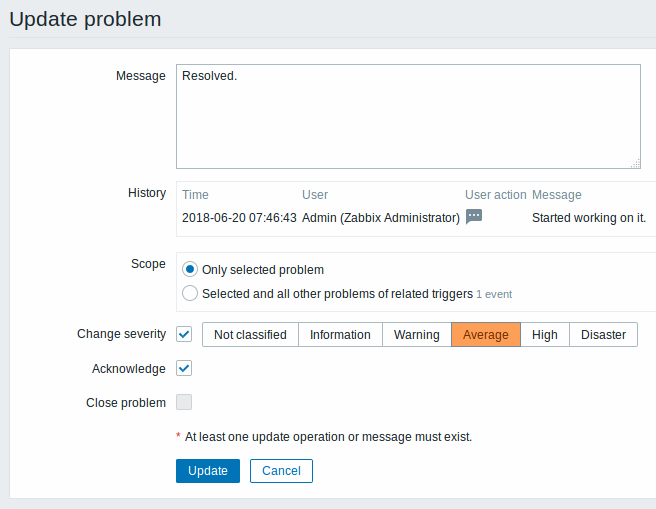Is this not what you were looking for? Switch to the current version or choose one from the drop-down menu.
13. Problem acknowledgment
Overview
Problem events in Zabbix can be acknowledged by users.
If a user gets notified about a problem event, they can go to Zabbix frontend, navigate from the problem list to the problem update screen and acknowledge the problem. When acknowledging, they can enter their comment for it, saying that they are working on it or whatever else they may feel like saying about it.
This way, if another system user spots the same problem, they immediately see if it has been acknowledged and the comments so far.
This way the workflow of resolving problems with more than one system user can take place in a more coordinated way.
Acknowledgment status is also used when defining action operations. You can define, for example, that a notification is sent to a higher level manager only if an event is not acknowledged for some time.
To acknowledge events and comment on them, a user must have at least read permissions to the corresponding triggers. To change problem severity or close problem, a user must have read-write permissions to the corresponding triggers.
There are several ways to access the problem update screen, which allows to acknowledge a problem.
- You may select problems in Monitoring → Problems and then click on Mass update below the list.
- You can click in the Ack column showing the acknowledgment status of problems in:
- Monitoring → Dashboard (Problems and Problems by severity widgets)
- Monitoring → Problems
- Monitoring → Problems → Event details
- Monitoring → Screens (Host group issues, Host issues, Problems by severity elements)
The Ack column contains either a 'Yes' or a 'No' link, indicating an acknowledged or an unacknowledged problem respectively. Clicking on the links will take you to the problem update screen.
- You can click on an unresolved problem cell in:
- Monitoring → Dashboard (Trigger overview widget)
- Monitoring → Overview
- Monitoring → Screens (Trigger overview element)
The popup menu contains an Acknowledge option that will take you to the problem update screen.
Updating problems
The problem update screen allows to:
- comment on the problem
- view comments and actions so far
- change problem severity
- acknowledge problem
- manually close problem

All mandatory input fields are marked with a red asterisk.
| Parameter | Description |
|---|---|
| Message | Enter text to comment on the problem (maximum 256 characters). |
| History | Previous activities and comments on the problem are listed, along with the time and user details. For the meaning of icons used to denote user actions see the event detail page. |
| Scope | Define the scope of such actions as changing severity, acknowledging or manually closing problems: Only selected problem - will affect this event only Selected and all other problems of related triggers - in case of acknowledgment/closing problem, will affect this event and all other problems that are not acknowledged/closed so far. If the scope contains problems already acknowledged or closed, these problems will not be acknowledged/closed repeatedly. On the other hand, the number of message and severity change operations are not limited. |
| Change severity | Mark the checkbox and click on the severity button to update problem severity. Since Zabbix 4.0.12, the checkbox for changing severity is available if read-write permissions exist for at least one of the selected problems. Only those problems that are read-writable will be updated when clicking on Update. If read-write permissions exist for none of the selected triggers, the checkbox is disabled. Before Zabbix 4.0.12, changing severity in this way was possible if read-write permissions existed for each selected problem. If at least one problem was not read-writable, the checkbox was disabled. |
| Acknowledge | Mark the checkbox to acknowledge the problem. This option is disabled if all selected problems are already acknowledged. If at least one is unacknowledged, the option is available and in this case it will be possible to acknowledge only the unacknowledged problem(s). It is not possible to add another acknowledgment for an already acknowledged problem (it is possible to add another comment though). |
| Close problem | Mark the checkbox to manually close the problem. Since Zabbix 4.0.12, the checkbox for closing a problem is available if the Allow manual close option is checked in trigger configuration for at least one of the selected problems. Only those problems will be closed that are allowed to be closed when clicking on Update. If no problem is manually closeable, the checkbox is disabled. Already closed problems will not be closed repeatedly. Before Zabbix 4.0.12, closing a problem in this way was possible if the Allow manual close option was checked in trigger configuration for each selected problem. If at least one problem was not manually closeable, the checkbox was disabled. |
Display
Based on acknowledgment information it is possible to configure how the problem count is displayed in the dashboard or maps. To do that, you have to make selections in the Problem display option, available in both map configuration and the Problems by severity dashboard widget. It is possible to display all problem count, unacknowledged problem count as separated from the total or unacknowledged problem count only.
Based on problem update information (acknowledgment, etc.) it is possible to configure update operations - send message or execute remote commands.
